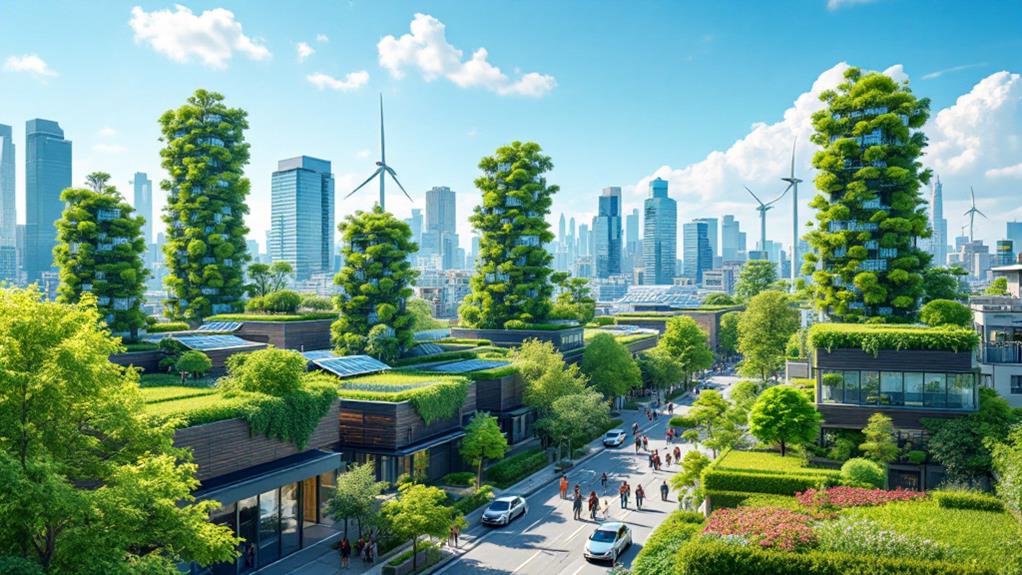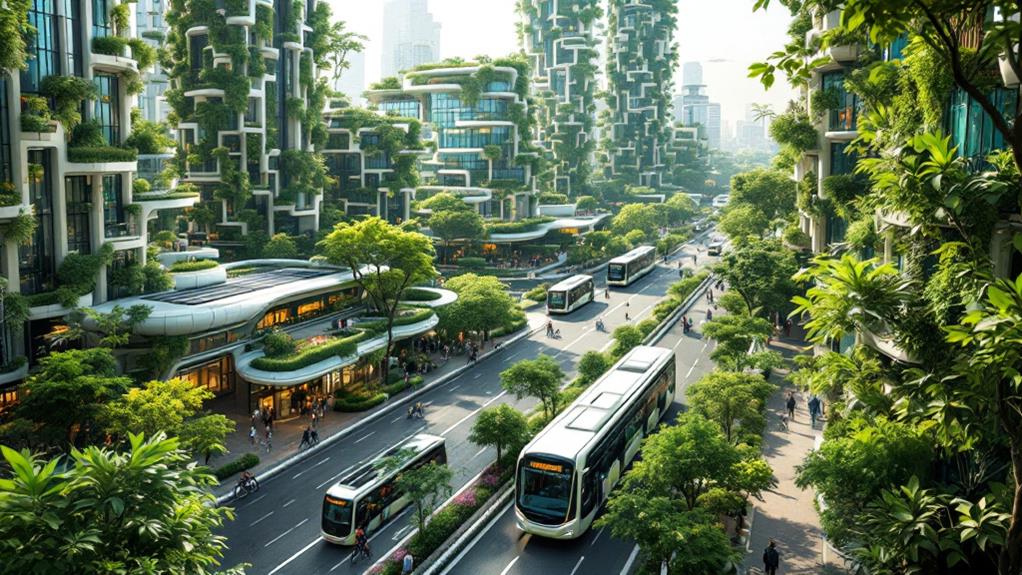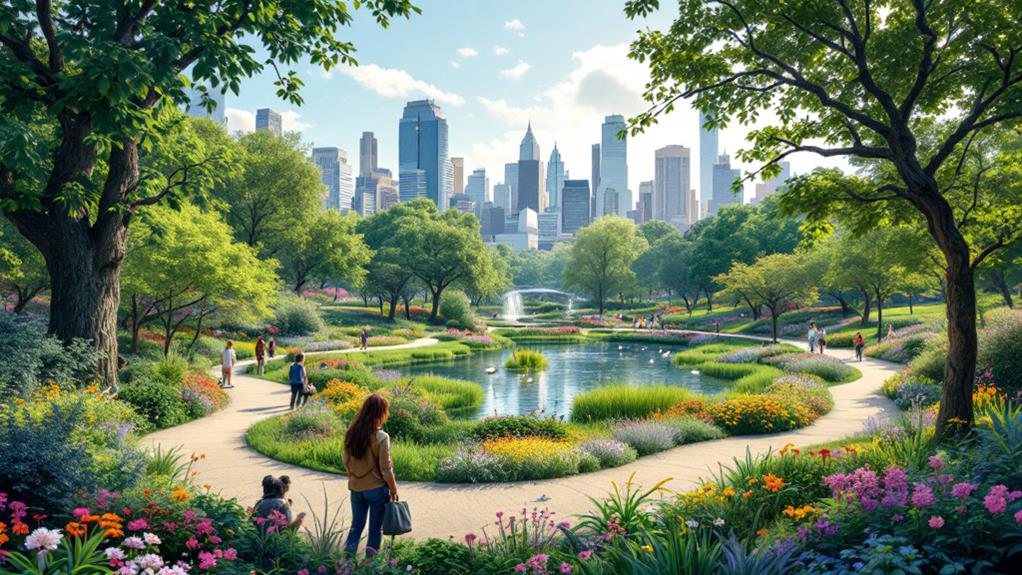Sustainable Living in the Largest Cities: Green Initiatives Around the World

You're seeing cities worldwide champion sustainable living with remarkable green initiatives. Cities like Singapore integrate lush vertical gardens, while Copenhagen leads with its extensive bike lane network. Oslo pushes for electric cars, aiming for carbon neutrality, and Curitiba's groundbreaking Bus Rapid Transit reduces car dependency. Amsterdam promotes cycling with over 400 km of bike paths. Vancouver and Reykjavik focus on renewable energy, and Zurich sets ambitious renewable targets. These cities blend nature with urban life by incorporating green spaces and urban farming, cutting waste through recycling programs, and driving renewable energy adoption. There's much more to investigate in these cutting-edge global efforts.
Defining Green Cities
When you think about green cities, envision urban areas that seamlessly blend nature with modern living. These cities prioritize sustainable urban development, ensuring that the health and well-being of both people and the environment are at the forefront. By incorporating abundant green spaces and efficient public transportation, green cities reduce their carbon footprint and improve the quality of life for their residents.
An essential aspect of these urban areas is their reliance on renewable energy sources. This minimizes their carbon footprint, making them more environmentally friendly. Urban farming practices are also adopted, providing fresh, local produce while promoting biodiversity. Green cities are committed to effective recycling programs, ensuring waste is minimized and resources are reused.
To further combat air pollution, green cities upgrade infrastructure to encourage biking and walking over driving. This not only reduces emissions but also enhances public health by encouraging active lifestyles. With a holistic approach to urban planning, these cities integrate sustainability as a core value in all aspects of city life. Ultimately, green cities serve as models of how urban environments can thrive while maintaining a strong commitment to environmental stewardship and the well-being of their inhabitants.
Global Green City Examples
Green cities around the world showcase creative strategies for sustainable urban living. In Singapore, often called the "Garden City," you'll find a sustainable city model that incorporates extensive green spaces like vertical gardens and parks. These initiatives not only improve biodiversity but also better air quality in this densely populated area. Moving to Copenhagen, the city is on a mission to become the globe's primary carbon-neutral capital by 2025. With over 350 kilometers of cycling trails, more than half of residents choose bicycles for daily commutes, cutting down on greenhouse gas emissions considerably.
Oslo presents another impressive example with its strong focus on electric vehicles. By 2023, 82% of new car sales were electric, thanks to considerable investments and incentives. This is part of the city's broader commitment to achieving carbon neutrality by 2050. In Brazil, Curitiba stands out as a trailblazer in public transport with its Bus Rapid Transit (BRT) system, and a groundbreaking solution called the Green Exchange Program, encouraging recycling.
Lastly, Amsterdam promotes a robust cycling culture with over 400 kilometers of bike paths. The city is also investing in renewable sources, like city-wide heating networks using industrial waste heat, aiming for carbon neutrality by 2050.
Innovative Urban Planning

Amidst the growing challenges of urbanization, cities worldwide are rethinking their landscapes through creative urban planning. You'll find that Copenhagen is leading the pack with its groundbreaking urban planning by developing over 350 kilometers of dedicated bike lanes. This extensive cycling infrastructure supports sustainable transportation and aims for carbon neutrality by 2025. Likewise, Curitiba in Brazil showcases a pioneering approach with its Bus Rapid Transit (BRT) system. This system integrates green spaces into its urban design, markedly reducing the need for cars.
In Barcelona, the Superblocks initiative is transforming neighborhoods by cutting car traffic and enhancing areas for pedestrians and cyclists. The goal is to create over 500 superblocks, making the city more pedestrian-friendly. Meanwhile, Singapore's City in a Garden initiative integrates greenery into urban architecture. Vertical gardens and widespread green spaces promote biodiversity and improve air quality.
Stockholm's commitment to fossil-fuel-free living by 2040 is backed by sustainable urban planning. The city boasts advanced waste management and extensive public transportation systems powered by renewable energy. These efforts highlight how cities can effectively incorporate creative urban planning to balance growth with environmental responsibility.
Renewable Energy Efforts
Cities around the world are increasingly turning to renewable energy to combat climate change and create sustainable urban environments. Zurich, Switzerland, leads the way by sourcing 90% of its power grid from renewable energy. The city aims to reduce energy consumption, targeting just 2,000 watts per person by 2050. Such efforts are essential for sustainable living and demonstrate a commitment to green initiatives.
In Copenhagen, Denmark, the push towards carbon neutrality is evident, with 74% of electricity generated from renewable sources. This city aims to achieve carbon neutrality by 2025, showcasing a model for others to follow. Likewise, Reykjavik, Iceland, illustrates the benefits of geothermal energy, with 90% of households heated through this clean energy source. The city plans to be fossil-fuel-free by 2050.
Vancouver, Canada, is committed to 100% renewable energy by 2050 through its Greenest City initiative, emphasizing green building standards and conservation. Meanwhile, Singapore is focusing on clean-energy vehicles to improve the adoption of renewable sources.
- Zurich: 90% renewable power, 2,000 watts per person goal
- Copenhagen: 74% renewable electricity, carbon neutrality by 2025
- Reykjavik: 90% geothermal heating, fossil-fuel-free by 2050
Urban Green Spaces and Biodiversity

As urban landscapes grow, the integration of green spaces becomes vital for improving biodiversity and creating healthier environments. You can look to Singapore, where vertical gardens transform the urban skyline, offering habitats for urban wildlife and contributing to sustainable living. These green initiatives not only beautify the city but also support a diverse array of species.
In cities like Amsterdam, the extensive cycling infrastructure and abundant green spaces actively promote biodiversity. By encouraging cycling over driving, Amsterdam fosters ecological resilience and reduces pollution. Likewise, Curitiba, Brazil, seamlessly integrates urban green spaces into city planning. These parks and gardens play a significant role in stormwater management and support local biodiversity, proving that thoughtful urban design can address multiple challenges.
Vancouver's focus on urban forestry reflects its commitment to increasing the tree canopy. This not only improves air quality but also supports diverse ecosystems, making the city a model of ecological stewardship. Meanwhile, Barcelona's Superblocks initiative reimagines urban areas by reducing car traffic and increasing green spaces. This approach improves urban biodiversity and encourages community engagement, demonstrating how cities can evolve to meet ecological and social needs at the same time.



